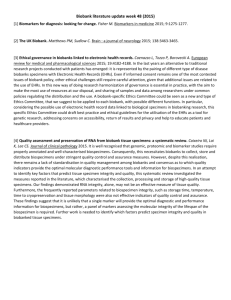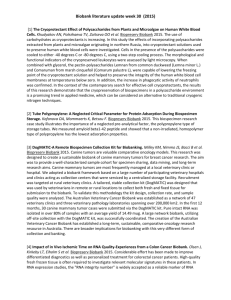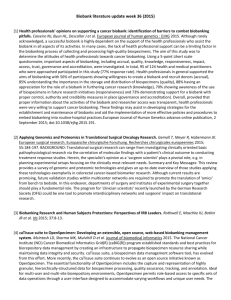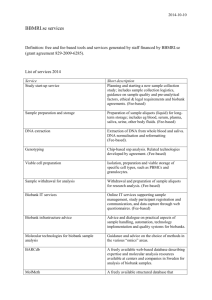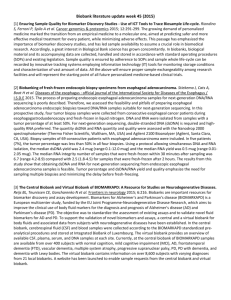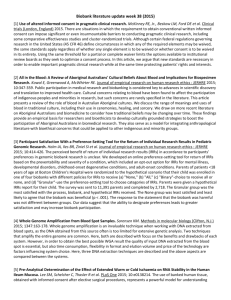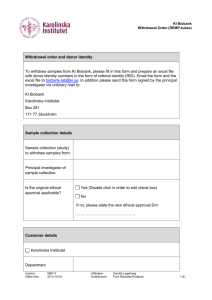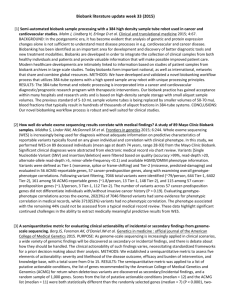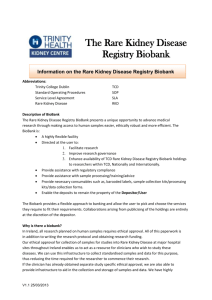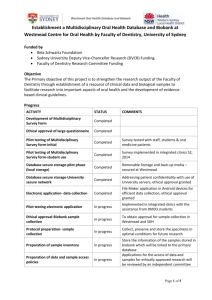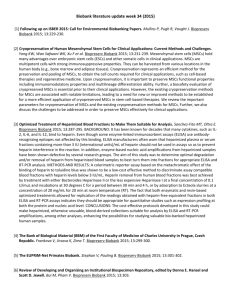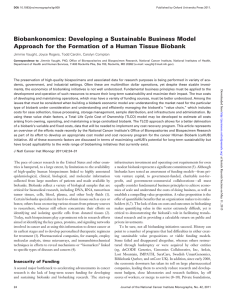Week 29 (2015-07-18)
advertisement
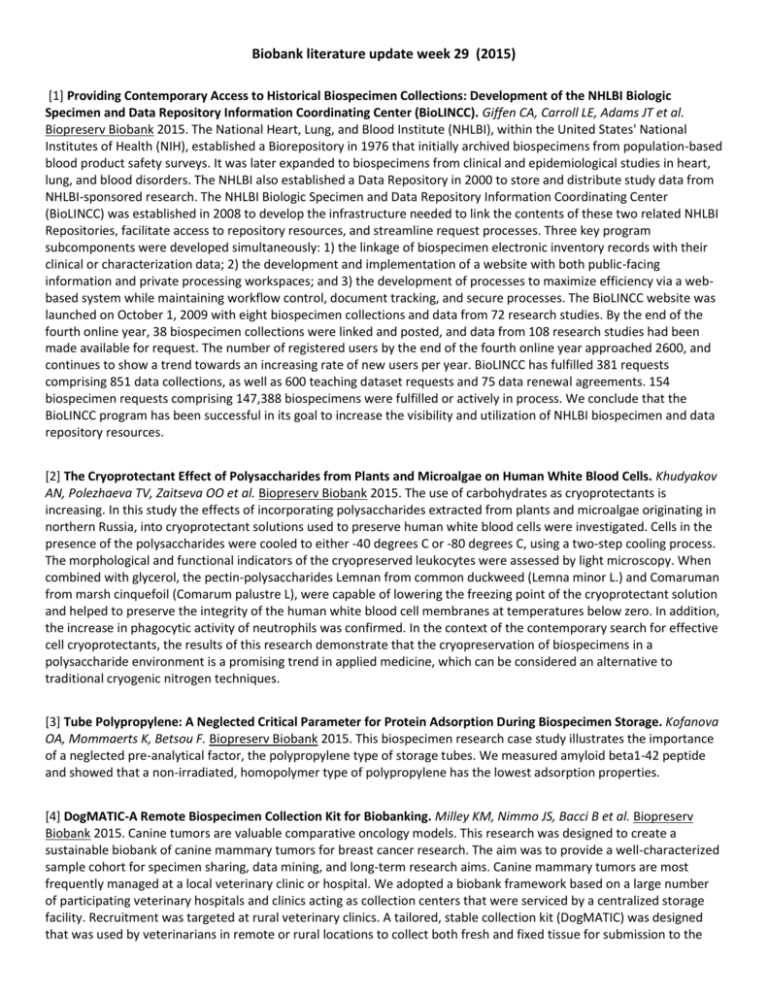
Biobank literature update week 29 (2015) [1] Providing Contemporary Access to Historical Biospecimen Collections: Development of the NHLBI Biologic Specimen and Data Repository Information Coordinating Center (BioLINCC). Giffen CA, Carroll LE, Adams JT et al. Biopreserv Biobank 2015. The National Heart, Lung, and Blood Institute (NHLBI), within the United States' National Institutes of Health (NIH), established a Biorepository in 1976 that initially archived biospecimens from population-based blood product safety surveys. It was later expanded to biospecimens from clinical and epidemiological studies in heart, lung, and blood disorders. The NHLBI also established a Data Repository in 2000 to store and distribute study data from NHLBI-sponsored research. The NHLBI Biologic Specimen and Data Repository Information Coordinating Center (BioLINCC) was established in 2008 to develop the infrastructure needed to link the contents of these two related NHLBI Repositories, facilitate access to repository resources, and streamline request processes. Three key program subcomponents were developed simultaneously: 1) the linkage of biospecimen electronic inventory records with their clinical or characterization data; 2) the development and implementation of a website with both public-facing information and private processing workspaces; and 3) the development of processes to maximize efficiency via a webbased system while maintaining workflow control, document tracking, and secure processes. The BioLINCC website was launched on October 1, 2009 with eight biospecimen collections and data from 72 research studies. By the end of the fourth online year, 38 biospecimen collections were linked and posted, and data from 108 research studies had been made available for request. The number of registered users by the end of the fourth online year approached 2600, and continues to show a trend towards an increasing rate of new users per year. BioLINCC has fulfilled 381 requests comprising 851 data collections, as well as 600 teaching dataset requests and 75 data renewal agreements. 154 biospecimen requests comprising 147,388 biospecimens were fulfilled or actively in process. We conclude that the BioLINCC program has been successful in its goal to increase the visibility and utilization of NHLBI biospecimen and data repository resources. [2] The Cryoprotectant Effect of Polysaccharides from Plants and Microalgae on Human White Blood Cells. Khudyakov AN, Polezhaeva TV, Zaitseva OO et al. Biopreserv Biobank 2015. The use of carbohydrates as cryoprotectants is increasing. In this study the effects of incorporating polysaccharides extracted from plants and microalgae originating in northern Russia, into cryoprotectant solutions used to preserve human white blood cells were investigated. Cells in the presence of the polysaccharides were cooled to either -40 degrees C or -80 degrees C, using a two-step cooling process. The morphological and functional indicators of the cryopreserved leukocytes were assessed by light microscopy. When combined with glycerol, the pectin-polysaccharides Lemnan from common duckweed (Lemna minor L.) and Comaruman from marsh cinquefoil (Comarum palustre L), were capable of lowering the freezing point of the cryoprotectant solution and helped to preserve the integrity of the human white blood cell membranes at temperatures below zero. In addition, the increase in phagocytic activity of neutrophils was confirmed. In the context of the contemporary search for effective cell cryoprotectants, the results of this research demonstrate that the cryopreservation of biospecimens in a polysaccharide environment is a promising trend in applied medicine, which can be considered an alternative to traditional cryogenic nitrogen techniques. [3] Tube Polypropylene: A Neglected Critical Parameter for Protein Adsorption During Biospecimen Storage. Kofanova OA, Mommaerts K, Betsou F. Biopreserv Biobank 2015. This biospecimen research case study illustrates the importance of a neglected pre-analytical factor, the polypropylene type of storage tubes. We measured amyloid beta1-42 peptide and showed that a non-irradiated, homopolymer type of polypropylene has the lowest adsorption properties. [4] DogMATIC-A Remote Biospecimen Collection Kit for Biobanking. Milley KM, Nimmo JS, Bacci B et al. Biopreserv Biobank 2015. Canine tumors are valuable comparative oncology models. This research was designed to create a sustainable biobank of canine mammary tumors for breast cancer research. The aim was to provide a well-characterized sample cohort for specimen sharing, data mining, and long-term research aims. Canine mammary tumors are most frequently managed at a local veterinary clinic or hospital. We adopted a biobank framework based on a large number of participating veterinary hospitals and clinics acting as collection centers that were serviced by a centralized storage facility. Recruitment was targeted at rural veterinary clinics. A tailored, stable collection kit (DogMATIC) was designed that was used by veterinarians in remote or rural locations to collect both fresh and fixed tissue for submission to the Biobank literature update week 29 (2015) biobank. To validate this methodology the kit design, collection rate, and sample quality were analyzed. The Australian Veterinary Cancer Biobank was established as a network of 47 veterinary clinics and three veterinary pathology laboratories spanning over 200,000 km2. In the first 12 months, 30 canine mammary tumor cases were submitted via the DogMATIC kit. Pure intact RNA was isolated in over 80% of samples with an average yield of 14.49 mug. A large network biobank, utilizing off-site collection with the DogMATIC kit, was successfully coordinated. The creation of the Australian Veterinary Cancer Biobank has established a long-term, sustainable, comparative oncology research resource in Australia. There are broader implications for biobanking with this very different form of collection and banking. [5] Impact of in Vivo Ischemic Time on RNA Quality-Experiences from a Colon Cancer Biobank. Olsen J, Kirkeby LT, Eiholm S et al. Biopreserv Biobank 2015. Considerable effort has been made to improve differentiated diagnostics as well as personalized treatment for colorectal cancer patients. High-quality fresh frozen tissue is often required to investigate relevant molecular signatures in these patients. In RNA expression studies, the "RNA integrity number" is widely accepted as a reliable marker of RNA quality. Here, we investigate the feasibility of obtaining high-quality tissue from a colon cancer biobank and the impact of in vivo ischemic time and various technical and clinicopathological factors on RNA quality. Biopsies were obtained immediately following the tumor removal. The time from clamping the main arterial supply to resection and removal of the tumor was used to estimate the in vivo ischemic time. We did not observe a significant difference in RNA quality between normal tissue and tumor tissue. We observed a significant correlation between in vivo ischemic time and RNA quality in normal tissue (r = -0.24, p<0.001) but not in tumor tissue. Male gender and laparoscopic procedure were also significantly associated with lower RNA quality in normal tissue only. In tumor tissue, poor differentiation was associated with low RNA quality. In conclusion, in vivo ischemic time, surgical procedure, and gender have minor but significant effects on the quality of RNA from normal colon tissue but not tumor tissue. Poorly differentiated tumors are associated with lower RNA quality. Although its impact is low, it can still be considered to note in vivo ischemic time in colon cancer specimen procurement. [6] Sharing and Reuse of Sensitive Data and Samples: Supporting Researchers in Identifying Ethical and Legal Requirements. Sariyar M, Schluender I, Smee C, Suhr S. Biopreserv Biobank 2015. Availability of and access to data and biosamples are essential in medical and translational research, where their reuse and repurposing by the wider research community can maximize their value and accelerate discovery. However, sharing human-related data or samples is complicated by ethical, legal, and social sensitivities. The specific ethical and legal requirements linked to sensitive data are often unfamiliar to life science researchers who, faced with vast amounts of complex, fragmented, and sometimes even contradictory information, may not feel competent to navigate through it. In this case, the impulse may be not to share the data in order to safeguard against unintentional misuse. Consequently, helping data providers to identify relevant ethical and legal requirements and how they might address them is an essential and frequently neglected step in removing possible hurdles to data and sample sharing in the life sciences. Here, we describe the complex regulatory context and discuss relevant online tools-one which the authors co-developed-targeted at assisting providers of sensitive data or biosamples with ethical and legal questions. The main results are (1) that the different approaches of the tools assume different user needs and prior knowledge of ethical and legal requirements, affecting how a service is designed and its usefulness, (2) that there is much potential for collaboration between tool providers, and (3) that enriched annotations of services (e.g., update status, completeness of information, and disclaimers) would increase their value and facilitate quick assessment by users. Further, there is still work to do with respect to providing researchers using sensitive data or samples with truly 'useful' tools that do not require pre-existing, in-depth knowledge of legal and ethical requirements or time to delve into the details. Ultimately, separate resources, maintained by experts familiar with the respective fields of research, may be needed while-in the longer term-harmonization and increase in ease of use will be very desirable. [7] Fair Shares and Sharing Fairly: A Survey of Public Views on Open Science, Informed Consent and Participatory Research in Biobanking. Joly Y, Dalpe G, So D, Birko S. PLoS One 2015; 10:e0129893. CONTEXT: Biobanks are important resources which enable large-scale genomic research with human samples and data, raising significant ethical concerns about how participants' information is managed and shared. Three previous studies of the Canadian public's opinion Biobank literature update week 29 (2015) about these topics have been conducted. Building on those results, an online survey representing the first study of public perceptions about biobanking spanning all Canadian provinces was conducted. Specifically, this study examined qualitative views about biobank objectives, governance structure, control and ownership of samples and data, benefit sharing, consent practices and data sharing norms, as well as additional questions and ethical concerns expressed by the public. RESULTS: Over half the respondents preferred to give a one-time general consent for the future sharing of their samples among researchers. Most expressed willingness for their data to be shared with the international scientific community rather than used by one or more Canadian institutions. Whereas more respondents indicated a preference for one-time general consent than any other model of consent, they constituted less than half of the total responses, revealing a lack of consensus among survey respondents regarding this question. Respondents identified biobank objectives, governance structure and accountability as the most important information to provide participants. Respondents' concerns about biobanking generally centred around the control and ownership of biological samples and data, especially with respect to potential misuse by insurers, the government and other third parties. Although almost half the respondents suggested that these should be managed by the researchers' institutions, results indicate that the public is interested in being well-informed about these projects and suggest the importance of increased involvement from participants. In conclusion, the study discusses the viability of several proposed models for informed consent, including e-governance, independent trustees and the use of exclusion clauses, in the context of these new findings about the views of the Canadian public.
